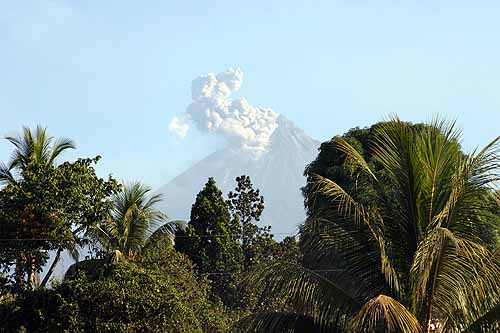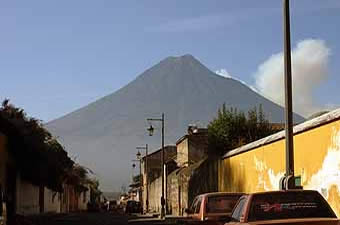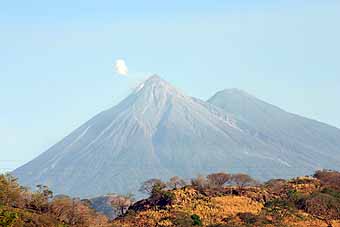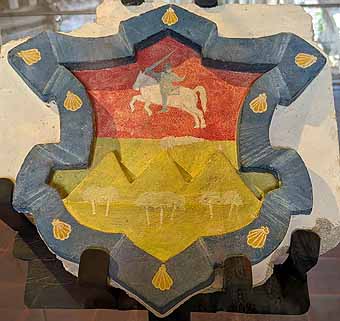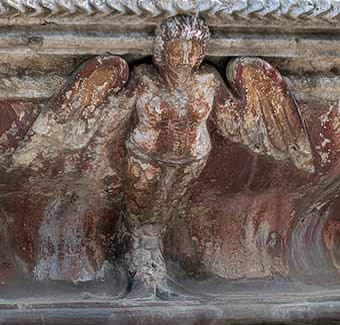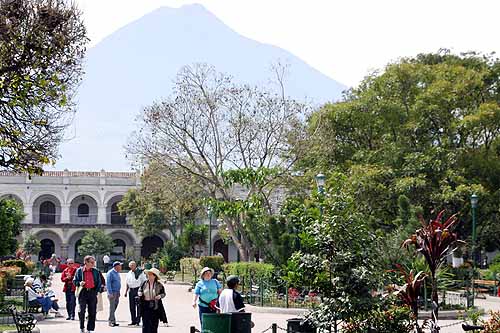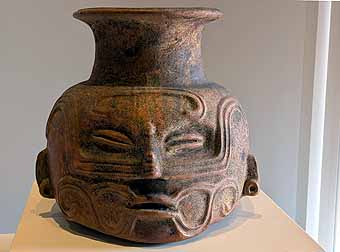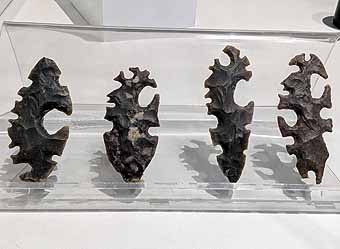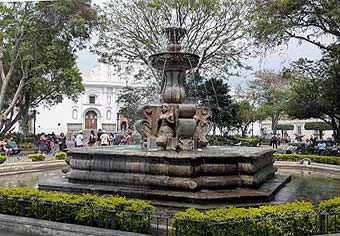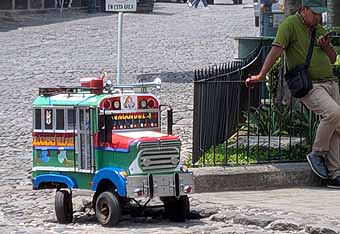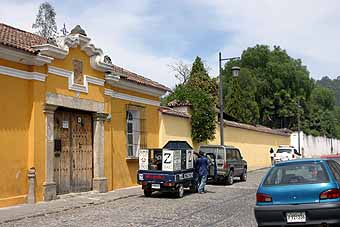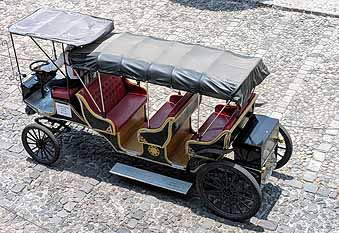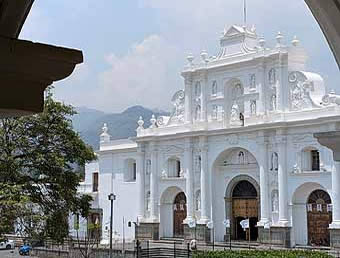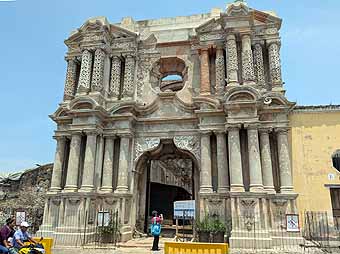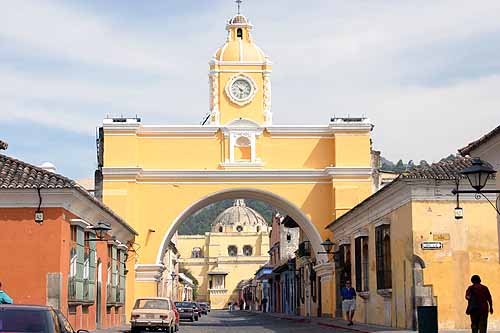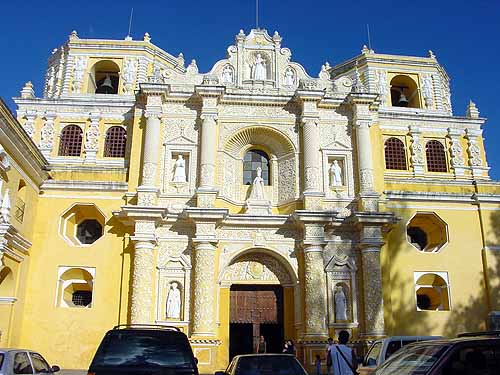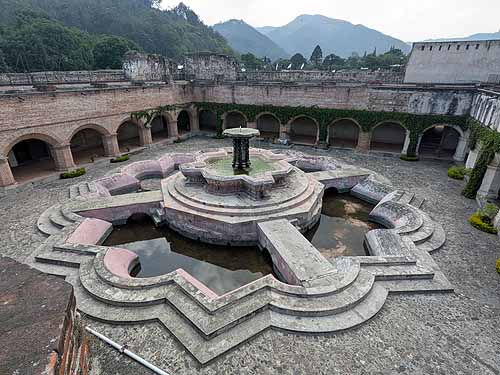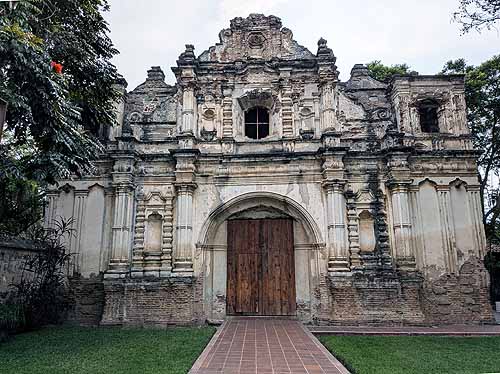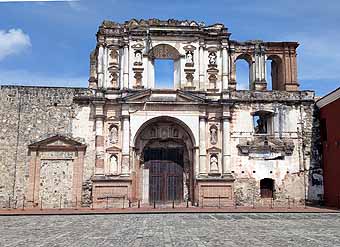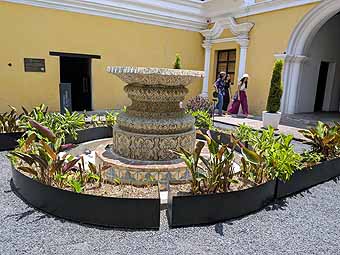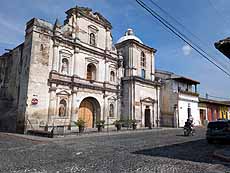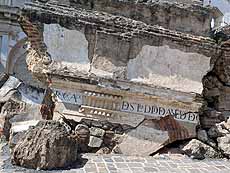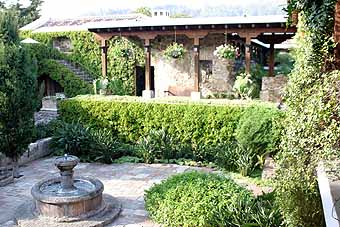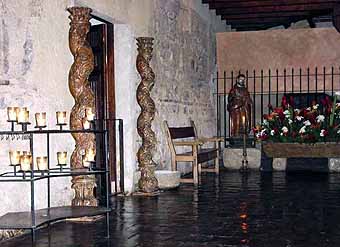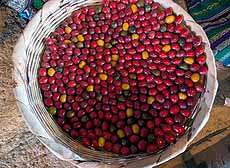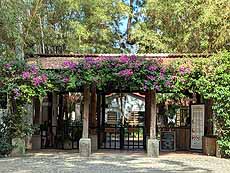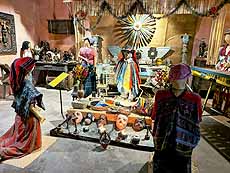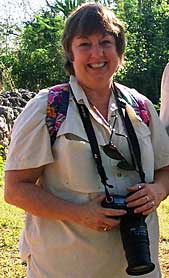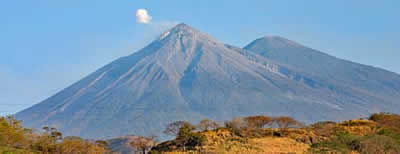 |
|
GUATAMALA'S CITY OF ANTIGUA SITS NEAR THREE VOLCANOES |
|||
Story and photos by Vicki Hoefling Andersen |
|||
Located near three impressive volcanoes about 25 miles west of Guatemala City is one of the oldest and most picturesque cities in all of the Americas: Antigua. In 1979 it was designated a UNESCO World Heritage Site for the beauty of its Spanish Baroque-influenced architecture, its churches and historic ruins, and its significance during the early colonial period of Central America.
At 5,029 feet in elevation, Antigua sits in the lap of three active volcanoes: Agua (above left), and Fuego and Acatenango (above right, left to right). And yes, that is smoke belching from Fuego. Founded in 1527 as “Santiago de los Caballeros de Guatemala” on the site of what was the Kaqchikel-Maya city of Iximche, Antigua was the capital of the Captaincy General of Guatemala, a region that included almost all of Central America plus the Mexican state of Chiapas. As regional capital it became the headquarters for 25 churches and convents.
The Escutcheon of Arms for Antigua was bestowed by Queen Juana I of Castilla in 1532 to identify a lineage and social hierarchy. The top half represents the apostle Santiago, under whose devotion the city was built, on horseback with a raised sword on a red background. The lower half depicts three volcanoes representing Agua, Fuego and Acatenango with Fuego erupting fire and the other two topped with crosses to symbolize evangelization. A predominant motif of Antigua is the figure of a winged mermaid which became a decorative element during the colonial period in Renaissance styles and long associated with fountains. But the city was plagued by a series of destructive earthquakes, with a final devastating upheaval in 1773 in what became known as the Santa Marta earthquake because the Big One, estimated a 7.5 magnitude, occurred on the feast day of Saint Martha, July 29. Initial ground-shaking began in May with aftershocks lasting until December. The immediate death toll was 500-600, and at least that many more from the resulting disease and starvation, so the Spanish Crown decided it was time to move the capital to Guatemala City. As customary when planning a Spanish town, Antigua was laid out in a square pattern with streets following the cardinal directions. A central plaza is surrounded by the most important buildings: the Cathedral, the Palace, and government administrative offices.
Parque Central is a small park in the heart of Antigua lined with trees and shrubs and dotted with benches. In the background is the Palacio de los Capitanes Generales or Royal Palace of the General Captains, an emblematic building reflecting the power, relevance and variety of functions performed within its walls during more than 200 years as seat of the Royal Audience and the General Captaincy of Guatemala. Abandoned after the 1773 earthquake and used as a warehouse, it was finally rescued, restored and refurbished. It is now home to The National Museum of Art of Guatemala (Museo Nacional de Arte de Guatemala), commonly referred to as MUNAG, and is a wonderful example of enabling the use of heritage buildings in protected historic areas.
MUNAG displays more than 3,000 years of Guatemala’s history and cultural heritage such as this anthropomorphic jar found in a tomb in Kaminaljuyu dating to 400-600 CE, and eccentric flints from Altar de Sacrificios from 550-900 CE. MUNAG’s symbol is the winged mermaid decorating the fountain of Inglesia La Merced.
Centerpiece of Parque Central is the Fountain of the Sirens, erected in 1739. Park vendors use novel methods to attract customers such as this purveyor of ice cream who modeled his “cart” after Guatemala’s famous “chicken buses.”
All streets in Antigua are cobblestone and most are lined with original colonial buildings. A rag-top touring car is a great way to view the city. More than a dozen earthquakes have taken a toll on Antigua’s buildings, and combined with repair and restoration efforts, much of the Baroque splendor has been lost, but the structures still inspire awe and introspection.
Cathedral de San Jose, aka Antigua Cathedral (above left), was begun in 1545 but was largely destroyed by the 1773 earthquake. Partially reconstructed and a fraction of its original size, the façade is notable for its intricate details. The main entrance hall now serves as the church and holds images of historical and religious value. Iglesia de Nuestra Senora del Carmen (above right) was nearly destroyed in the earthquake of 1773. It was reconstructed, but earthquakes hit again in 1917-18 and 1976. Fortunately, the façade survived fairly well.
A block north of Parque Central is one of the city’s most recognizable architectural landmarks, the Arco de Santa Catalina, built in 1694 as part of a convent. The nuns lived in one building and taught in the school across the road. Because they had taken vows of seclusion, they needed to avoid contact with the outside world, so the arch was constructed to conceal their movement between buildings.
Iglesia La Merced, described as “ultra baroque Guatemalan style.” features two bell towers and is one of the city’s best-preserved churches still in use, though itʻs the third to be graced with that name. Established by the Mercedarian Order in 1548, the first church was destroyed by a lahar spewing down the slopes of Volcan Agua. Then earthquakes leveled the second building. What you see today was constructed from 1749-1767 using a different type of construction that made it much more resistant to the shaking earth. But as with the other religious orders, in 1773 when the capital relocated, so did the Mercedarians. Time and more tremblers did it no favors, and in 1853 restoration work began. Stucco work on the façade features a Moorish-influenced arabesque design, and a niche holds a statue of the Blessed Virgin Mary of Mercy for which the church is named. It is home to many pieces of exceptional art, stunning retablos, and an antique image of Jesus Nazareno which is reverently exhibited as part of the Palm Sunday and Good Friday processions through the city.
The Fountain of los Pescados (fish) in the interior courtyard of Iglesia La Merced is one of the largest colonial fountains in Latin America. https://en.wikipedia.org/wiki/Latin_America. It is more than 88 feet in diameter and shaped like a water lily, which interestingly enough had great significance to the ancient Maya. The fountain, decorated with winged mermaids, was used by the monks to raise fish for food. Waterlily motifs also appear on the entry arch to the church.
Construction commenced on Inglesia San Jose El Viejo around 1742 with the intent to house a carved image of Saint Joseph, but an earthquake caused considerable damage to the unfinished church. In 1759 another effort was made and the church was completed two years later. Recognized as a National Monument in 1944 due to its cultural significance, it has become a popular wedding venue, blending history and romance amid the remains. Restoration is underway.
Inglesia y Colegio de la Compania de Jesus is a Baroque-style church and Jesuit monastery built from 1690-1698. Destroyed by an earthquake in 1717, it was used as a textile factory, then transformed into a market for vendor stalls. In 1992 Spain’s International Cooperation Agency for Development restored the monastery portion of the building and its fountain, and established an international educational center whose curriculum, most fittingly, includes restoring historic structures.
Inglesia y Museo San Agustin is another example of repurposing historic buildings. Constructed in 1657 by the Jesuits, it suffered significant damage during the 1717 earthquake; then the rebuilt edifice inaugurated in 1761 was severely damaged again in 1773. A museum located in the partly restored ruins showcases an exhibition titled “Fragments of the Past” featuring valuable archaeological pieces and a room dedicated to pre-Hispanic Maya culture. Much of the church’s final destruction remains as an example for visitors to understand the devastation inflicted on Antigua by the natural world.
Santo Domingo Church and Monastery was one of the largest and most important in the city, established by the Dominicans in 1538. It had two towers with ten bells, was filled with treasures, but was destroyed in the 1773 earthquake. Filled with period furnishings, it was eventually sold, then converted into the Hotel Casa Santo Domingo. Six different museums explore the country’s history through colonial art, religious paintings, sculptures, silverware and pottery, and Maya archaeological artifacts.
Coffee has been a vital part of Guatemalan culture and history for centuries; the fertile volcanic soil and ideal climate produce some of the world’s finest beans. Introduced by Jesuit priests in the 1700s, Guatemala is one of the world’s largest coffee producers. La Azotea Coffee Finca, about a 10-15 minute drive on the outskirts of Antigua, grows fine Arabica coffee under a canopy of shade trees. The plantation features factory tours, displays explaining the entire coffee production process past and present, a chocolate museum, and beautiful grounds where visitors can stroll at will or relax at tables sheltered from the sun. La Azotea is also home to Casa K'ojom Musica Maya, a museum of traditional Maya music and related artifacts. This diorama illustrates how the Maya blended their ceremonies and other indigenous beliefs with Catholicism. The nearby volcanoes offer great hiking and climbing. Antigua is a shoppers delight noted for ceramics, textiles, wooden ceremonial masks, and jade jewelry and other unusual pieces in the local jade factories. During Semana Santa, the Holy Week preceding Easter, Antigua is home to Guatemala’s biggest festival which draws visitors from around the globe. Streets are festooned with elaborate designs made with flower petals and colored sawdust, while pious processions carrying sacred relics make their way along the cobblestone lanes. About the author:
|
